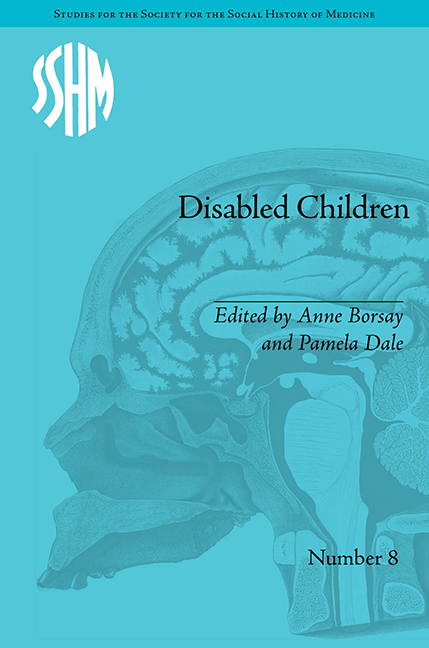Book contents
- Frontmatter
- Contents
- Acknowledgements
- Notes on Contributors
- Introduction: Disabled Children – Contested Caring
- 1 Club Feet and Charity: Children at the House of Charity, Soho, 1848–1914
- 2 Insanity, Family and Community in Late-Victorian Britain
- 3 The Mixed Economy of Welfare and the Care of Sick and Disabled Children in the South Wales Coalfield, c. 1850–1950
- 4 The Question of Oralism and the Experiences of Deaf Children, 1880–1914
- 5 Exploring Patient Experience in an Australian Institution for Children with Learning Disabilities, 1887–1933
- 6 From Representation to Experience: Disability in the British Advice Literature for Parents, 1890–1980
- 7 Treating Children with Non-Pulmonary Tuberculosis in Sweden: Apelviken, c. 1900–30
- 8 Health Visiting and Disability Issues in England before 1948
- 9 Spanish Health Services and Polio Epidemics in the Twentieth Century: The ‘Discovery’ of a New Group of Disabled People, 1920–70
- 10 Cured by Kindness? Child Guidance Services during the Second World War
- 11 Education, Training and Social Competence: Special Education in Glasgow since 1945
- 12 Hyperactivity and American History, 1957–Present: Challenges to and Opportunities for Understanding
- Notes
- Index
7 - Treating Children with Non-Pulmonary Tuberculosis in Sweden: Apelviken, c. 1900–30
- Frontmatter
- Contents
- Acknowledgements
- Notes on Contributors
- Introduction: Disabled Children – Contested Caring
- 1 Club Feet and Charity: Children at the House of Charity, Soho, 1848–1914
- 2 Insanity, Family and Community in Late-Victorian Britain
- 3 The Mixed Economy of Welfare and the Care of Sick and Disabled Children in the South Wales Coalfield, c. 1850–1950
- 4 The Question of Oralism and the Experiences of Deaf Children, 1880–1914
- 5 Exploring Patient Experience in an Australian Institution for Children with Learning Disabilities, 1887–1933
- 6 From Representation to Experience: Disability in the British Advice Literature for Parents, 1890–1980
- 7 Treating Children with Non-Pulmonary Tuberculosis in Sweden: Apelviken, c. 1900–30
- 8 Health Visiting and Disability Issues in England before 1948
- 9 Spanish Health Services and Polio Epidemics in the Twentieth Century: The ‘Discovery’ of a New Group of Disabled People, 1920–70
- 10 Cured by Kindness? Child Guidance Services during the Second World War
- 11 Education, Training and Social Competence: Special Education in Glasgow since 1945
- 12 Hyperactivity and American History, 1957–Present: Challenges to and Opportunities for Understanding
- Notes
- Index
Summary
Introduction
Perched on the coast in the south-western Swedish province of Halland on the Kattegatt, the body of water separating Sweden from Denmark, is one of the country's fashionable spas. A walk around the grounds and among the older buildings leads to a small cemetery, whose 134 graves belong mostly to young children from distant parts of the country who were buried between 1927 and 1948. Immediately questions come to mind. What was this place? Who were these children? How and why did they come to be buried here, so far from their homes? The story is revealed by delving into the health conditions in Europe and Sweden around the turn of the last century. It is a story of social problems, disease, politics, economics, science and dreams of a better world for individuals and society as a whole.
In the late nineteenth and early twentieth centuries, tuberculosis came to be recognized as one of the major killers among infectious diseases and one of the leading threats to health. It is difficult to establish exactly how many people suffered from the disease due to the problems of identifying the infection. Although the pathogen was not identified by Robert Koch until 1882, it is generally acknowledged that tuberculosis mortality peaked in Europe in the late 1800s before beginning to decline; for Sweden this occurred in the 1870s.
- Type
- Chapter
- Information
- Disabled ChildrenContested Caring, 1850–1979, pp. 103 - 116Publisher: Pickering & ChattoFirst published in: 2014

